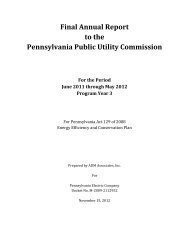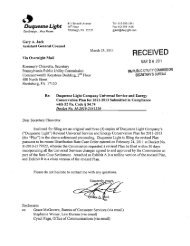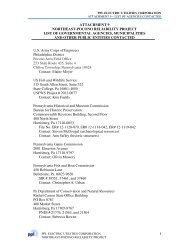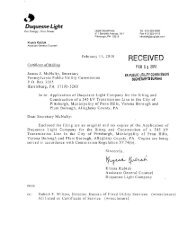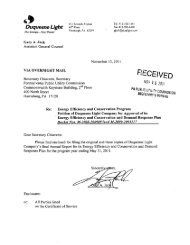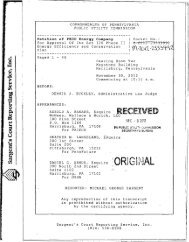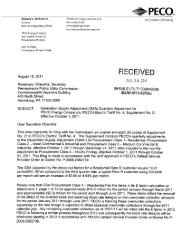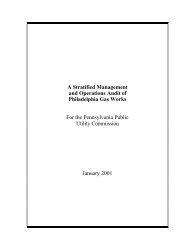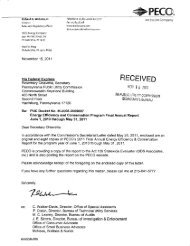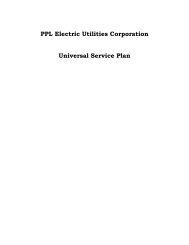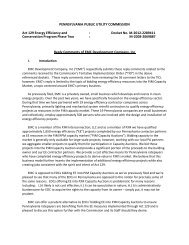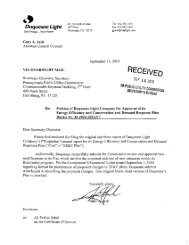George Lomax Heath Consultants Inc
George Lomax Heath Consultants Inc
George Lomax Heath Consultants Inc
You also want an ePaper? Increase the reach of your titles
YUMPU automatically turns print PDFs into web optimized ePapers that Google loves.
Presented by:<br />
<strong>George</strong> <strong>Lomax</strong><br />
<strong>Heath</strong> <strong>Consultants</strong> <strong>Inc</strong>.<br />
1
Discussion Overview<br />
• How did it start and develop?<br />
• What is the relationship with OPS?<br />
• What does the membership look like?<br />
• What does the Committee do?<br />
• What does the Guide look like?<br />
• What is the DIMP Guidance?<br />
• What is the value of GPTC for me ?<br />
2
How did it start and develop?<br />
3
GPTC HISTORY<br />
• Natural Gas Pipeline Safety Act in 1968<br />
• DOT Office of Pipeline Safety formed<br />
-Interim adoption of industry standard d ASME B31.8<br />
-Decision to develop performance-based regulation<br />
• Discussions between OPS and ASME<br />
-Publication of regulations and recommended practices<br />
-Mutual participation in development of “guide material”<br />
4
• Formation of ASME Gas Piping Standards Committee<br />
to write proven methods & practices guidance<br />
• Safety regulations published November 12 ,1970<br />
• GPSC Guide published December 15, 1970<br />
5
• GPSC changed to Gas Piping Technology<br />
Committee (GPTC) in 1982<br />
• AGA became sponsor and secretariat in 1990<br />
• American National Standards Institute<br />
accreditation in 1992<br />
-ASC GPTC Z380 committee<br />
-Guide is ASC Z380.1<br />
6
What is the relationship with<br />
OPS?<br />
7
• Historic partnership<br />
• OPS members of GPTC<br />
• Reference of GPTC Guide in NPRM<br />
• Letter from Associate Administrator for<br />
Pipeline Safety<br />
8
“The Office of Pipeline Safety believes that the Guide for<br />
Gas Transmission and Distribution Piping Systems is of<br />
significant assistance to gas piping system operators<br />
in their efforts to comply with the Minimum<br />
Federal Safety Standards for the Transportation<br />
of Natural and Other Gas by Pipeline (49 CFR<br />
Part 192). Your method of presentation is an excellent<br />
means of helping operators comply with the standards.”<br />
Office of Pipeline Safety<br />
9
• John Frantz is the GPTC Liaison i to<br />
PHMSA<br />
• John meets regularly with Jeff<br />
Wiese<br />
10
What does the membership<br />
look like?<br />
11
• Currently 99 members representing the<br />
distribution, manufacturing,<br />
transmission, i and regulatory segments<br />
of the gas industry.<br />
12
Distribution:<br />
General:<br />
Manufacturing:<br />
Regulatory:<br />
Transmission:<br />
13
GPTC Members<br />
MA<br />
OR<br />
MN<br />
MI<br />
NV IL PA<br />
OH<br />
NY<br />
CT<br />
NJ<br />
CA<br />
AZ<br />
CO<br />
OK<br />
MO<br />
AR<br />
IN<br />
KY<br />
TN<br />
AL<br />
WV<br />
VA<br />
DC<br />
TX<br />
LA<br />
14
Pennsylvania is well represented:<br />
John Frantz – PECO (Retired)<br />
Andrew Benedict – Opvantek<br />
Victor Frederick, III – Omega Tools<br />
Steve Groeber – PGW<br />
Ralph Graeser – PA PUC (Pending)<br />
Jim Heintz – UGI<br />
Larry Krummert – Columbia Gas of PA<br />
Seth Mackay-Smith – UMAC<br />
(Dan O’Leary)<br />
Jack Mackin – EQT (Pending)<br />
<strong>Heath</strong>er Risley – UGI<br />
15
• Technically based<br />
• Independent<br />
• Members represent their profession<br />
16
What does the<br />
committee do?<br />
17
• Develop Guide material to help comply<br />
with the Federal (and State) Pipeline<br />
Safety Regulations, 49 CFR Parts 191<br />
and 192.<br />
18
• Review NTSB & State accident reports<br />
• Comment on ANPR & NPRM<br />
•Respond to NTSB recommendations<br />
• Propose changes to regulations<br />
19
• Further safe application of technology<br />
• Develop technical reports<br />
• Publish the GPTC “Guide”<br />
20
What does the Guide<br />
look like?<br />
21
Prepared by the<br />
Gas Piping Technology<br />
Committee<br />
ASC GPTC Z380<br />
22
• Structured in the same fashion as the regulations<br />
(Parts 191 and 192).<br />
• <strong>Inc</strong>ludes design recommendations, material<br />
reference, and recommended practices.<br />
• <strong>Inc</strong>ludes “how to” supplementary recommendations<br />
related to the regulations.<br />
23
192.703 FEDERAL STANDARD<br />
§192.703 General (11-12-70)<br />
(a)…<br />
(b)...<br />
(c) Hazardous leaks must be repaired<br />
promptly.<br />
24
GUIDE MATERIAL<br />
Appendix, GMA G-192-11<br />
Establishes gas leakage detection guidelines.<br />
Leak classification and action criteria i table<br />
Grade 1<br />
Grade 2<br />
Grade 3<br />
25
What is the DIMP Guidance?<br />
26
Writing DIMP Guidance<br />
Requested by PHMSA & NAPSR to develop<br />
companion DI guidance<br />
• Provide different options for operators<br />
• Develop in parallel with regulation, i.e., before<br />
an NPRM is published<br />
• Based on the DIMP Phase I Report (Prepared<br />
for PHMSA in 2005)<br />
27
Writing DIMP Guidance<br />
GPTC asked to form a task group:<br />
•<strong>Inc</strong>lude members from outside of GPTC<br />
(particularly regulators and small operators)<br />
•Address the needs of small operators –<br />
preserve the KISS principal<br />
•Follow the 7 elements of Phase I<br />
•Provide examples to indicate the level of<br />
effort expected<br />
•Make available as a stand-alone appendix<br />
to the Guide<br />
28
What is the value of GPTC for<br />
me?<br />
29
• Historic relationship with OPS<br />
• Independent group not industry<br />
committee<br />
• Technically based committee<br />
• Membership includes Federal and State<br />
regulators and NTSB<br />
30
Guide is used by:<br />
• Federal & State regulators<br />
• Transmission (pipeline) operators<br />
• Distribution (LDCs) operators<br />
• Municipalities<br />
i • Master Meter operators.<br />
31
Many gas operators, both large and<br />
small, incorporate sections of the Guide<br />
in their O&M manuals.<br />
32
Where are we now?<br />
DIMP Guidance published and available<br />
www.AGA.org (Publications)<br />
DIMP Appendix $49<br />
Entire Guide $430<br />
Task Group formed to sync up Guidance with Final DIMP<br />
Rule<br />
Expect publication of the new version in August 2010<br />
33
GPTC<br />
Meets three times a year<br />
Always looking for knowledgeable members<br />
Welcomes visitors<br />
Next meetings<br />
November 2010 - San Diego, California<br />
March 2011 - Clearwater, Florida<br />
34
The Gas Piping Technology Committee<br />
provides value to gas operators.<br />
35




